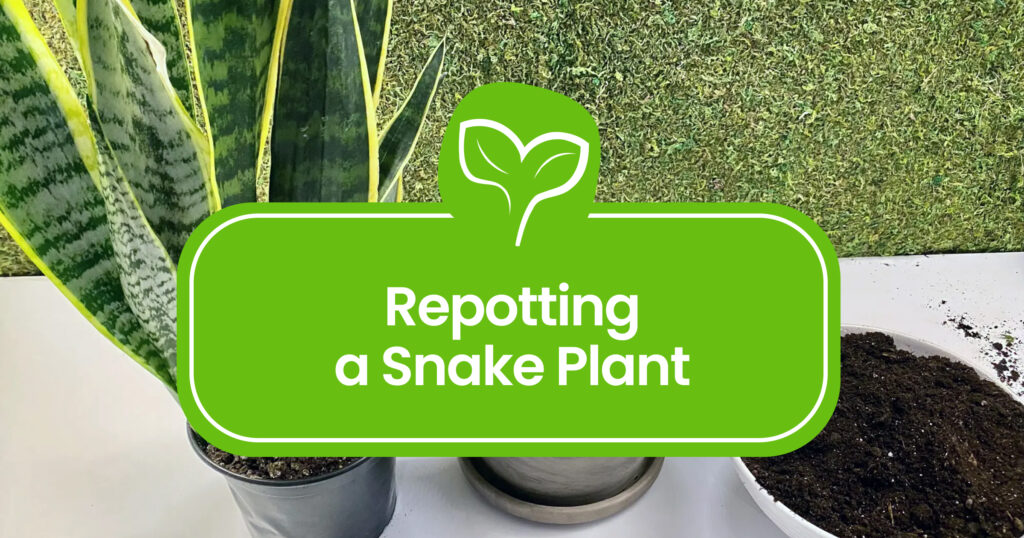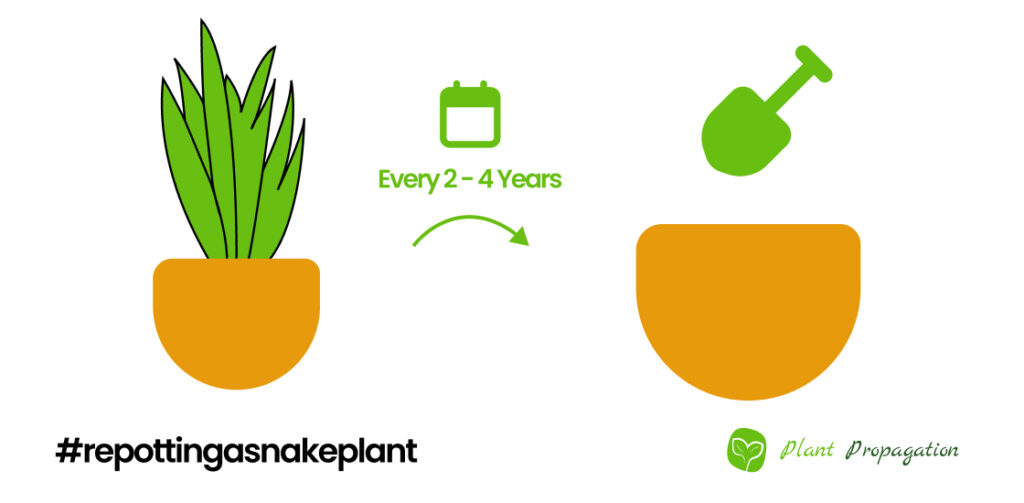
Snake plants, also called mother-in-law’s tongues, are known for their low-maintenance nature. And they’re just as easy to repot! Repotting a Snake Plant isn’t done just for aesthetics, because this simple practice is crucial for maintaining and promoting health and growth.
Read on to find out how to repot a snake plant!
When should you repot a snake plant?
Technically, you can repot snake plants at any time of the year. However, the optimal time is in late winter or early spring, right before the new growing season. That allows the plant time to recover before it enters dormancy. But how do you know when to move your snake plant into a new container? Here are some signs to look out for.
- Visible roots – Roots protruding from the soil surface or drainage hole indicate that your plant has run out of space. While snake plants like to be slightly root-bound, they still need free room to spread.
- The soil drains fast – If the soil dries out quickly or water runs straight through the drainage holes, it’s time to repot your plant into a fresh potting mix. Soil draining too fast signals that it has deteriorated and doesn’t hold onto moisture and nutrients effectively.
- Slow growth – Your plant may be running low on nutrients and space in its pot if its growth has slowed.
- Plant keeps falling over – If your plant is top-heavy and keeps falling over, it indicates that the plant doesn’t have enough room to spread in its pot.
- The plant is producing several new shoots – Snake plants grow shoots from the base of the plant. Those shoots eventually establish and request their own space and nutrients. Use those new shoots to propagate your snake plant!
How often should you repot a snake plant?
Repotting your snake plant is not something you should be doing monthly or even annually. The exact frequency depends on the growth rate and age of your plant. Understanding your plant and repotting it when necessary promotes its growth and root health and helps to prevent diseases.
Young plants still establishing their roots and growing fast request more frequent repotting. Move them into a bigger container every 1 to 2 years. Mature plants can go 2-4 years in the same pot.

How to repot a snake plant – step-by-step guide
- Gather your materials – Before you dig your snake plant out of its pot, gather everything you’ll need for repotting. Have your new pot, potting mix, a knife or pruning shears, and a watering can in arm’s reach.
- Prepare the new pot – Grab your new container and some fresh potting mix. Add a layer of the potting mix at the bottom of the container.
- Remove the plant from its old pot – Lay the plant on its side and gently twist and wiggle it to remove it from its pot. Alternatively, you can turn the plant upside down and lightly tap the sides. If your snake plant is in a plastic pot, you can cut it open.
- Inspect the plant – Revolve excessive soil from the root ball and closely inspect the plant. Trim off any damaged roots and leaves.
- Repot the plant – Grab your new pot and place your snake plant in the center of it, using one hand to hold it straight. Fill the pot with your fresh potting mix, gently patting down to secure it.
- Water the plant – Give the plant a light watering – stop as soon as the water starts to drain from the drainage holes.
- Aftercare – Place your freshly repotted plant in a spot where it receives indirect light. Water again once the top inches of soil have dried out. Closely monitor your plant, make adjustments when needed, and allow it time to recover.
Best soil for repotting a snake plant
Snake plants hold onto water and are prone to root rot – therefore, they prefer their soil to be on the dry side. Choosing a well-draining and aerated potting medium is crucial for your plant to thrive. So, opt for a coarse and light potting mix.
Cactus and succulent potting mixes are chunky and drain freely – they work brilliantly for snake plants. If you opt for potting soil, add some perlite or pebbles to make it less heavy.
Repotting a snake plant – tools
The right tools and materials will make the repotting process smooth and effective. Here is everything you’ll need.
- Pot/container – Repot your snake plant in a new container slightly bigger than the old one. Ensure that the chosen container has drainage holes. Ceramic and clay containers work great for snake plants.
- Fresh potting mix – Replace the old potting mix with a new one to nourish your plant. This is a good one for Snake Plants.
- Pruning shears/knife – Cut off any damaged roots and leaves.

Additional tips
Do you want to ensure a successful repotting process? Here are some simple yet effective tips.
- Choose the correct pot size. Your new pot should be slightly bigger than the old one but not too big – snake plants prefer snug spaces.
- Prune away damaged parts before repotting the plant.
- You might be tempted to thoroughly water your plant after repotting it, but a light watering will do! Snake plants prefer dry environments.
Two common challenges arise during or after repotting – root damage and shock response. If you notice damaged roots, trim them off and provide the plant with optimal care. Regular care is also needed for plants experiencing shock. Allowing freshly repotted snake plants time to adjust works magic!
Tailoring the process depending on your snake plant variety
Snake plants come in hundreds of varieties, each with varying characteristics and needs. Some types request repotting more often than others, and some are more sensitive to repotting stress.
Always research your specific plant variety and consider factors such as growth rate, leaf structure, and root size. Tailor the repotting process accordingly to meet the needs of your plant.
To sum it up
Repotting your snake plant now and then is essential to ensure you’re providing your plant with enough room to thrive. Looking out for signs that suggest your snake plant requires more space will reward you with a healthy and active plant. The process is easy – simply follow the step-by-step guide provided in this article!
Frequently Asked Questions
Mature plants should be repotted every 2 to 4 years. Younger snake plants benefit from more regular repotting – do it every 1 to 2 years.
How to repot a snake plant with root rot?
Remove the plant from its pot and examine the damage – cut off any damaged roots, leaves, and stems. Prepare a clean container with fresh, well-draining soil and repot the plant. Optionally, use a root stimulant to speed up the recovery.
When should I report my snake plant?
There are some signs to look out for. Repot your snake plant if the soil drains too quickly, the roots are growing out of the drainage holes, the pot is cracking or falling over, or the plant is producing several new shoots.
Does a snake plant like to be root-bound?
Snake plants like to be slightly root-bound. However, they still need to have some room to spread.
What kind of soil do I use to repot a snake plant?
Snake plants like to be on the dry side as they’re prone to root rot. Use a light, well-draining potting mix.

